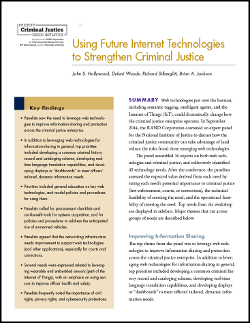
Future World Wide Web technologies commonly labeled as being part of Web 3.0 and Web 4.0 could substantially change how the criminal justice enterprise operates. These notably include Semantic Web technologies, intelligent agents, and the Internet of Things. In September 2014, RAND conducted an expert panel for the National Institute of Justice to discuss how the criminal justice community can take advantage of (and reduce the risks from) these emerging technologies. The top unifying theme from the panel was to leverage web technologies to improve information-sharing and protection across the criminal justice enterprise, and to address challenges that the new technologies raise. Another major theme was improving practitioners' knowledge of web technologies. Priorities included general education on key web technologies, and model policies and procedures for using them. A third theme was to improve the networking infrastructure needed to support web technologies (and other applications), especially for courts and corrections. Fourth, several needs became apparent related to leveraging wearable and embedded sensors (part of the Internet of Things), with an emphasis on using sensors to improve officer health and safety. Finally, panelists frequently noted the importance of civil rights, privacy rights, and cybersecurity protections in using the emerging technologies for criminal justice. While there were few needs about these topics specifically, panelists noted that more than half of the needs raised security, privacy, or civil rights concerns, or had implied requirements on these topics.
